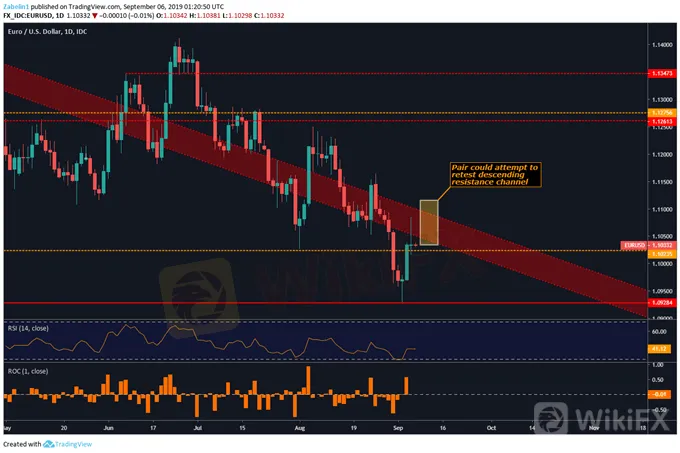简体中文
繁體中文
English
Pусский
日本語
ภาษาไทย
Tiếng Việt
Bahasa Indonesia
Español
हिन्दी
Filippiiniläinen
Français
Deutsch
Português
Türkçe
한국어
العربية
Euro May Rise vs US Dollar if Jobs Data Boosts Fed Rate Cut Bets
Abstract:The Euro may rise against the US Dollar if US nonfarm payrolls data undershoots expectations and boosts the case for more accommodative Fed monetary policy.
EUR/USD, US NFPs, US Dollar – TALKING POINTS
EUR/USD may re-enter 18-month descending resistance channel
A poor print of US nonfarm payrolls data may be a key catalyst
Premium on liquidity may return if political détentes deteriorate
EUR/USD may suffer if US nonfarm payrolls data misses the 160k growth estimate for August. An underperformance in this report could bolster the case for the Fed to implement accommodative policy measures and would likely be reflected in overnight index swaps. As it stands, market participants are already pricing in a better-than-even chance of a 50 basis-point cut in October.
However, given what Fed Chairman Jerome Powell had said at the Jackson Hole symposium and recent comments by some of the more cautious central bank members, officials are not as dovish as many believe they are. As such, market participants may – once again – be setting themselves up for disappointment if the Fed conveys a less-dovish outlook than what investors are pricing in.
EUR/USDs rebound from a two-year low comes as demand for haven assets – like the US Dollar – is declining amid the emergence of ethereal market optimism.
However, those concerns may quickly resurface as the fragile mosaic of political stability shatters under the weight of its own almost-inevitable disintegration. Under these circumstances, data that fuels rate cut expectations may continue to pressure US Dollar crosses until the urgency for liquidity and anti-risk assets makes a reprise and causes EUR/USD to resume its dominant downtrend.
Chart of the Day: EUR/USD May Look to Retest Descending Resistance Channel

EUR/USD chart created using TradingView
EUR/USD TRADING RESOURCES
Disclaimer:
The views in this article only represent the author's personal views, and do not constitute investment advice on this platform. This platform does not guarantee the accuracy, completeness and timeliness of the information in the article, and will not be liable for any loss caused by the use of or reliance on the information in the article.
Read more

KVB Market Analysis | 30 August: JPY Strengthens Against USD Amid Strong Q2 GDP and BoJ Rate Hike Speculation
The Japanese Yen (JPY) strengthened against the US Dollar (USD) on Thursday, boosted by stronger-than-expected Q2 GDP growth in Japan, raising hopes for a BoJ rate hike. Despite this, the USD/JPY pair found support from higher US Treasury yields, though gains may be capped by expectations of a Fed rate cut in September.

KVB Market Analysis | 28 August: Yen Strengthens on BoJ Rate Hike Hints; USD/JPY Faces Uncertainty
The Japanese Yen rose 0.7% against the US Dollar after BoJ Governor Kazuo Ueda hinted at potential rate hikes. This coincided with a recovery in Asian markets, aided by stronger Chinese stocks. With the July FOMC minutes already pointing to a September rate cut, the US Dollar might edge higher into the weekend.

KVB Market Analysis | 27 August: AUD/USD Holds Below Seven-Month High Amid Divergent Central Bank Policies
The Australian Dollar (AUD) traded sideways against the US Dollar (USD) on Tuesday, staying just below the seven-month high of 0.6798 reached on Monday. The downside for the AUD/USD pair is expected to be limited due to differing policy outlooks between the Reserve Bank of Australia (RBA) and the US Federal Reserve. The RBA Minutes indicated that a rate cut is unlikely soon, and Governor Michele Bullock affirmed the central bank's readiness to raise rates again if necessary to combat inflation.

KVB Market Analysis | 23 August: JPY Gains Ground Against USD as BoJ Signals Possible Rate Hike
JPY strengthened against the USD, pushing USD/JPY near 145.00, driven by strong inflation data and BoJ rate hike expectations. Japan's strong Q2 GDP growth added support. However, USD gains may be limited by expectations of a Fed rate cut in September.
WikiFX Broker
Latest News
Spotware Unveils cTrader Store, Global Marketplace for Algo Creators
Elderly Trader Loses RM2.1M in WhatsApp Forex Scam
Gigamax Scam: Tracking Key Suspects in RM7 Million Crypto Fraud
CFI Partners with MI Cape Town, Cricket Team
Doo Financial Expands Reach with Indonesian Regulatory Licenses
WikiFX Review: Is IQ Option trustworthy?
5 Questions to Ask Yourself Before Taking a Trade
Quadcode Markets: Trustworthy or Risky?
Avoid Fake Websites of CPT Markets
Webull Canada Expands Options Trading to TFSAs and RRSPs
Currency Calculator



